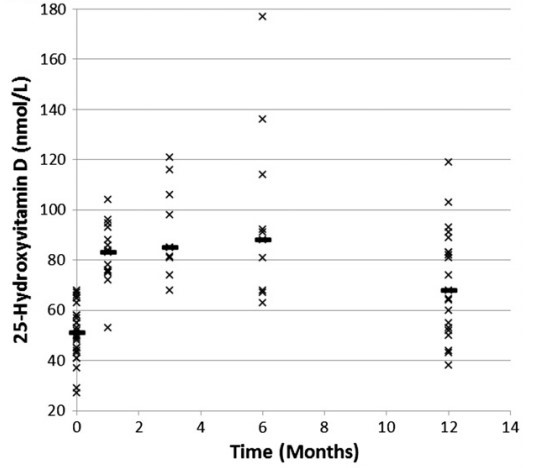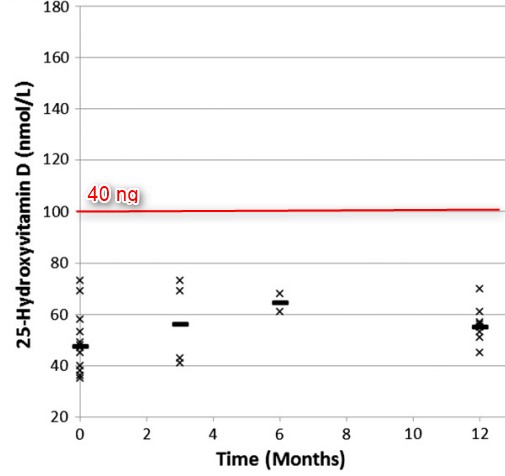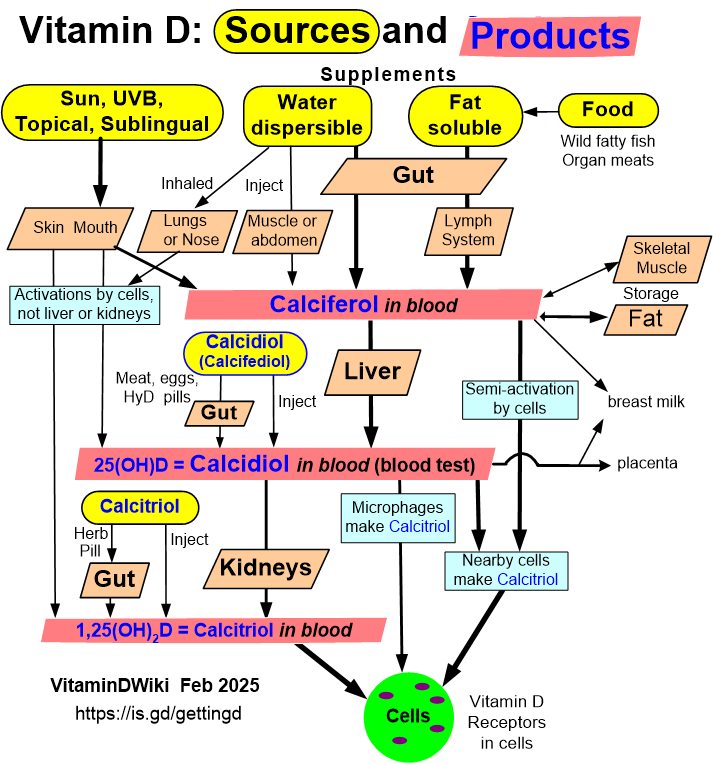Single dose (up to 60,000 IU) vitamin D raised levels in 87 percent of Cystic fibrosis patients – RCT
Single high-dose oral vitamin D3 (stoss) therapy--a solution to vitamin D deficiency in children with cystic fibrosis?
J Cyst Fibros. 2013 Mar;12(2):177-82. doi: 10.1016/j.jcf.2012.08.007. Epub 2012 Sep 19.
Shepherd D1, Belessis Y2, Katz T2, Morton J2, Field P2, Jaffe A2.
OBJECTIVES:
To determine the safety and efficacy of stoss therapy on vitamin D levels over a 12 month period in children with cystic fibrosis and vitamin D deficiency (<75 nmol/L).
STUDY DESIGN:
Retrospective chart review of 142 paediatric CF patients from 2007 till 2011.
RESULTS:
Thirty eight children received stoss therapy and 37 children with vitamin D deficiency were not treated and served as a control group. The stoss treated group had a significant and sustained increase in 25-hydroxyvitamin D levels measured at 1, 3, 6 and 12 months post treatment compared to controls (94.82 ± 41.0 nmol/L, p=0.001; 81.54 ± 24.6 nmol/L, p=0.001; 92.18 ± 36.5 nmol/L, p=0.008 and 64.6 ± 20.0 nmol/L, p=0.006 respectively). At 12 months post intervention, the mean difference in vitamin D levels from baseline between the stoss treated group and controls was significant at 15 nmol/L compared to 5 nmol/L (p=0.038).
CONCLUSION:
Stoss therapy effectively achieves and maintains levels of 25-hydroxyvitamin D greater than 75 nmol/L over 12 months.
PMID: 22998937
📄 Download the PDF from VitaminDWiki
Stoss therapy (Table 1)
| ** | ||||
|---|---|---|---|---|
| 25-Hydroxyvitamin D level (nmol/L) |
<3 years | 3–12 years | >12 years | |
| ≤25 | 200 000 IU | 400 000 IU | 600 000 IU | |
| 25–50 | 150 000 IU | 350 000 IU | 500 000 IU | |
| 50–75 | 100 000 IU | 200 000 IU | 300 000 IU | ** |
Responders

13% did not respond

VitaminDWiki expects that a different form of vitamin D would have resulted in responses.
Sublingual,Inaled, Injection topical, patch, gut friendly, etc.
as well as adding Omega-3 and/or Magnesium
See also VitaminDWiki
Cystic Fibrosis Foundation recommends vitamin D dose, patients are taking even more – March 2015
Death due to cystic fibrosis reduced about 4X due to 250000 IU of vitamin D – RCT June 2012
Might use Vitamin D for cystic fibrosis and topically on skin – June 2011
Cystic Fibrosis category listing has items along with related searches
Loading Dose of Vitamin D category listing has items along with related searches
500,000 IU of vitamin D cut in half the hospital days following a lung failure – RCT 2015
Vitamin D loading doses of up to 400,000 IU OK for adolescents – meta-analysis Dec 2014
Loading dose of 300,000 IU of vitamin D does not last long – March 2014
Many ways to increase Vitamin D - click on chart for details

